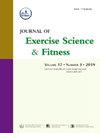比较25分钟肌肉电刺激与90分钟全身阻力训练对身体成分和力量的影响:为期20周的干预
IF 2.4
2区 医学
Q2 SPORT SCIENCES
引用次数: 0
摘要
目的肌电刺激(EMS)和传统阻力训练(TradRT)是目前广泛应用的提高肌力和肌体成分的方法。然而,采用多周纵向设计的比较研究仍然有限。本研究旨在探讨20周的EMS与TradRT对体力活动成年人身体成分和力量表现的影响。方法46例患者随机分为EMS组(n = 22)和TradRT组(n = 24)。EMS组每周进行两次25分钟的全身EMS训练,而TradRT组每周进行两次90分钟的全身阻力训练。结果在基线、10周和20周进行体重、体重指数(BMI)、脂肪百分比和最大力量的评估。所有变量均观察到显著的时间效应(p <;0.001),表明两组患者均有改善。然而,组×时间相互作用显示出不同的适应模式。TradRT组表现出更大的体脂率降低,在卧推、腿推、肩推、三头肌俯卧撑和腹部力量方面的力量增加。相反,EMS组的体重和身体质量指数下降幅度更大。对肱二头肌弯曲强度没有观察到显著的相互作用效应。EMS和TradRT在改善力量和身体成分方面都有效,但TradRT在力量发展和脂肪减少方面更有效,而EMS在体重和BMI降低方面更有效。这些研究结果表明,EMS可能是无法进行高负荷阻力训练的个体的可行替代方案,而TradRT在最大限度地增强力量和减少脂肪方面仍然优越。本文章由计算机程序翻译,如有差异,请以英文原文为准。
Comparing the effects of 25-minute electrical muscle stimulation vs. 90-minute full-body resistance training on body composition and strength: A 20-week intervention
Objectives
Electromyostimulation (EMS) and traditional resistance training (TradRT) are widely used methods for improving muscle strength and body composition. However, comparative studies employing a multi-week longitudinal design remain limited. This study aimed to investigate the effects of 20 weeks of EMS vs. TradRT on body composition and strength performance in physically active adults.
Methods
Forty-six participants were randomly assigned to either the EMS group (n = 22) or the TradRT group (n = 24). The EMS group performed twice-weekly, 25-min whole-body EMS sessions, while the TradRT group completed twice-weekly, 90-min full-body resistance training sessions.
Results
Assessments of body weight, body mass index (BMI), fat percentage, and maximal strength were conducted at baseline, 10 weeks, and 20 weeks. A significant time effect was observed for all variables (p < 0.001), indicating improvements in both groups. However, group × time interactions revealed distinct adaptation patterns. The TradRT group exhibited greater reductions in body fat percentage and superior strength gains in bench press, leg press, shoulder press, and triceps pushdown, and abdominal strength. Conversely, the EMS group showed greater reductions in body weight and BMI. No significant interaction effect was observed for biceps curl strength. Both EMS and TradRT were effective in improving strength and body composition, but TradRT led to greater strength development and fat reduction, while EMS was more effective for weight and BMI reduction.
Conclusions
These findings suggest that EMS may serve as a viable alternative for individuals unable to engage in high-load resistance training, whereas TradRT remains superior for maximizing strength and fat loss.
求助全文
通过发布文献求助,成功后即可免费获取论文全文。
去求助
来源期刊
CiteScore
5.10
自引率
3.60%
发文量
54
审稿时长
31 days
期刊介绍:
The Journal of Exercise Science and Fitness is the official peer-reviewed journal of The Society of Chinese Scholars on Exercise Physiology and Fitness (SCSEPF), the Physical Fitness Association of Hong Kong, China (HKPFA), and the Hong Kong Association of Sports Medicine and Sports Science (HKASMSS). It is published twice a year, in June and December, by Elsevier.
The Journal accepts original investigations, comprehensive reviews, case studies and short communications on current topics in exercise science, physical fitness and physical education.

 求助内容:
求助内容: 应助结果提醒方式:
应助结果提醒方式:


